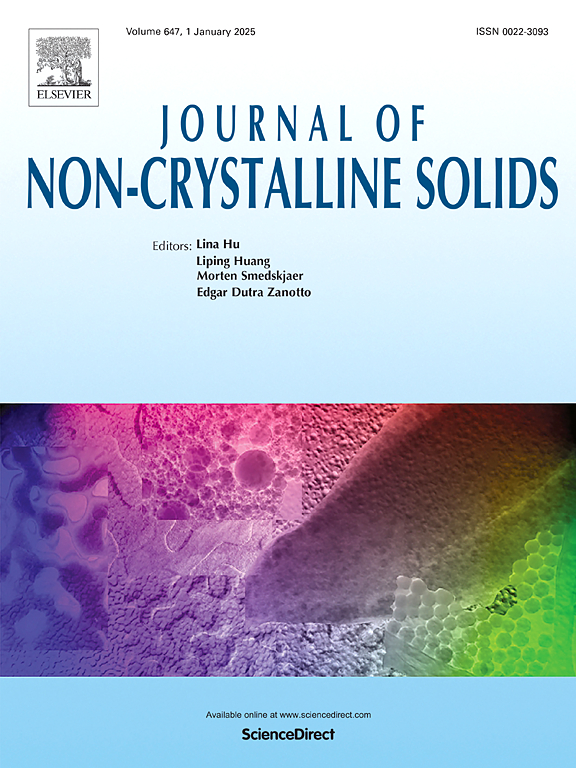热处理硅胶气凝胶,增强机械性能,隔热,油水分离和自清洁
IF 3.5
3区 材料科学
Q1 MATERIALS SCIENCE, CERAMICS
引用次数: 0
摘要
在全球能源危机和环境问题日益严峻的背景下,再加上柔性电子器件、可穿戴设备等新兴领域的蓬勃发展,具有机械柔性的多功能气凝胶材料成为研究的重点和挑战。针对传统二氧化硅气凝胶脆性高、力学性能差的关键问题,本研究通过对有机硅源的二氧化硅气凝胶进行热改性,成功开发出一种具有优异力学性能和多功能特性的新型材料。采用溶胶-凝胶法制备的气凝胶以甲基三乙氧基硅烷和二甲基二氧基硅烷为前驱体,在200℃下进行热处理,其三维网络骨架内颈部融合明显增强。这导致抗压强度增加57%,达到166.2 kPa(在80%应变下),同时保持良好的弹性。热处理还优化了孔隙结构,使材料在800°C时保持84%的质量,并表现出0.0424 W·m(⁻¹·K)的低导热系数。红外热成像表明,在200℃的加热条件下,该材料仍能保持148℃的温差。此外,气凝胶具有超疏水性(水接触角>;144°)和超亲油性,对各种油的吸附量超过其自重的15倍,并且在多次循环中性能稳定。通过创新的热处理工艺,我们实现了气凝胶性能的协同优化,为建筑节能、环境修复和柔性电子产品的应用提供了一种有前途的新型多功能材料。本文章由计算机程序翻译,如有差异,请以英文原文为准。
Heat treatment of silica aerogel for enhanced mechanical properties, heat insulation, oil-water separation and self-cleaning
Against the backdrop of the increasingly severe global energy crisis and environmental issues, coupled with the vigorous development of emerging fields such as flexible electronic devices and wearable equipment, multifunctional aerogel materials with mechanical flexibility have become a key research focus and challenge. Addressing the critical issues of high brittleness and poor mechanical properties in traditional silica aerogels, this work successfully developed a novel material with both excellent mechanical performance and multifunctional characteristics by thermally modifying silica aerogels derived from organosilicon sources. Using methyl triethoxysilane and dimethyl diethoxysilane as precursors, the aerogel prepared via the sol-gel method underwent heat treatment at 200°C, resulting in significantly enhanced neck fusion within its three-dimensional network skeleton. This led to a 57% increase in compressive strength to 166.2 kPa (at 80% strain) while maintaining good elasticity. The heat treatment also optimized the pore structure, enabling the material to retain 84% of its mass at 800°C and exhibit a low thermal conductivity of 0.0424 W·m⁻¹·K⁻¹. Infrared thermal imaging demonstrated that it could maintain a temperature difference of 148°C under heating at 200°C. Additionally, the aerogel exhibited superhydrophobicity (water contact angle144°) and superoleophilicity, with an adsorption capacity for various oils exceeding 15 times its own weight and stable performance over multiple cycles. Through innovative heat treatment processes, we achieved synergistic optimization of aerogel performance, providing a promising new multifunctional material for applications in building energy efficiency, environmental remediation, and flexible electronics.
求助全文
通过发布文献求助,成功后即可免费获取论文全文。
去求助
来源期刊

Journal of Non-crystalline Solids
工程技术-材料科学:硅酸盐
CiteScore
6.50
自引率
11.40%
发文量
576
审稿时长
35 days
期刊介绍:
The Journal of Non-Crystalline Solids publishes review articles, research papers, and Letters to the Editor on amorphous and glassy materials, including inorganic, organic, polymeric, hybrid and metallic systems. Papers on partially glassy materials, such as glass-ceramics and glass-matrix composites, and papers involving the liquid state are also included in so far as the properties of the liquid are relevant for the formation of the solid.
In all cases the papers must demonstrate both novelty and importance to the field, by way of significant advances in understanding or application of non-crystalline solids; in the case of Letters, a compelling case must also be made for expedited handling.
 求助内容:
求助内容: 应助结果提醒方式:
应助结果提醒方式:


